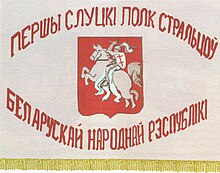Slutsk uprising

The uprising in Slutsk ( Belarusian Слуцкі збройны чын ; also Slutsk defense action called) was an anti-Bolshevik uprising with the aim of the Belarusian People's Republic rebuild. It took place from November 27 to December 31, 1920 in the Belarusian city of Slutsk and the surrounding villages.
background
With the preliminary peace agreement of the Polish-Soviet war , later laid down in the Riga Peace Treaty , new borders were set between the Soviet Union and Poland . The city of Slutsk thus became part of the Belarusian Soviet Socialist Republic in 1919 .
The new rulers made themselves unpopular among the population , in particular through expropriations in the wake of war communism . Farmers in particular suffered from collectivization measures. In addition, the city of Slutsk had a large number of Belarusian nationalist intellectuals who longed for the Belarusian People's Republic .
course
On November 14, 1920, a congress took place in a private house, which elected a provisional government, the Sluzker Rada. The Slutsk Rada decided to offer armed resistance against the Red Army and managed to mobilize 10,000 people from different cities. Two regiments were formed: the first, led by Lieutenant Colonel Achrem Gaurilovich, and the second, led by Semjanjunka. Both regiments were combined in the Sluzker Brigade, which was led by Anton Sokal-Kutylouski. The headquarters of the brigade was later relocated from Slutsk to Siemiežava as the Red Army advanced. The Vajacki marš served as the hymn of the uprising .
The fighting began on November 27, 1920. The fighters managed to achieve military success in the places Kapyl, Zimkawitschy and Wyzna. Nevertheless, the Slutsk rebels were technically inferior to the Red Army. The fighting continued until the end of December when the Bolsheviks finally crushed them.
Aftermath
Nowadays, the Slutsk uprising is remembered mainly within the Belarusian opposition and is considered an important factor in Belarusian national consciousness. Organizations such as the Belarusian Christian Democrats , Partyja BNF or the youth organization Malady Front are committed to honoring the participants in the Slutsk uprising.
In the Upper Bavarian Mittenwald , Belarusian emigrants erected the memorial for Belarusian prisoners of war , which commemorates the participants in the Slutsk uprising.
Web links
Individual evidence
- ↑ Slucak . belarusguide.com (English)
- ↑ Documentation: Sluzker Uprising (Слуцкае паўстанне) 2011. ONT YouTube
- ↑ a b c Віншуем з днём Герояў - з 91-й гадавінай Слуцкага збройнага чыну! . bchd.info (Belarusian)
- ↑ БНФ ушануе ўгодкі Слуцкага Збройнага Чыну narodny.org (Belarusian)
- ↑ Слуцкі збройны чын. Маладафронтаўцы прынялi прысягу (абноўлена) mfront.net (Belarusian)


